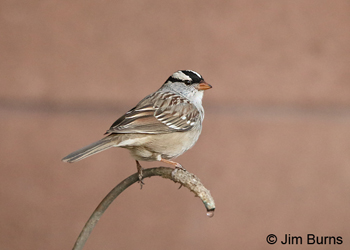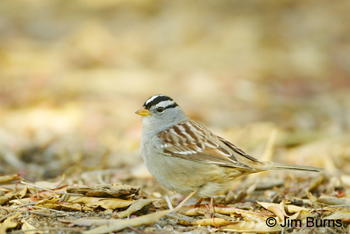|
White-crowned Sparrow (gambelii) in winter |
Back in the day when I was a lister, like a lot of listers I paid little or no attention to subspecies because . . . well, they weren’t countable. Just another reason why a lot of listers miss opportunities to better educate themselves about the birds they profess to love, and simply neglect to enjoy many cool birds. Don’t be one of those listers!
Since I’ve fled from the dark side of hard core listing and no longer keep count, I’m frequently reminded of this, most recently last week when I noticed what at first looked like a new yardbird at our backyard water feature—active, plump, bright, stripy—what the heck is that!? Grabbing binoculars and easing over to the French doors, I began my long overdue education on White-crowned Sparrow subspecies.
We’ve had White-crowneds in our yard every winter since we moved into our present neighborhood. They are neat little birds, locally common here in winter, easily recognizable, and typically heard before they are seen. We love the distinctive song, and I’ve seen them every day of every winter (October through April or May), but I’m somewhat embarrassed to admit I’d never really looked at our White-crowneds until last week when at first glance I thought I was seeing something different.
A binocular look told me that yes indeed I was seeing, not just another White-crowned, but a slightly larger, paler-backed, much more contrastingly head-striped version of this taken-for-granted-by-me Zonotricia sparrow than I was used to in our yard. What had first caught my eye was how large and bright the three white head stripes appeared. Of course this is a species which can raise and lower its crown feathers for various reasons, but I realized through the binoculars this was not the reason the “new” White-crowneds looked different than the “usual” ones feeding alongside them, and a little searching through the literature soon told me we had, presumably for the first time, two different subspecies of White-crowned Sparrow visiting us for the winter, oriantha, the Rocky Mountain version and gambelii, the subspecies which breeds in the far northwest from Alaska to Hudson Bay.
The most apparent visual difference between oriantha (and the northeastern leucophrys) and gambelii is in the loral area, that part of the eyestripe which extends forward from the eye to the base of the bill. The former is black lored, the latter white lored. Oddly enough, though you’d think the lateral crown stripe of gambelii would be more noticeable because of its white lores, something about the contrast between the stripes and the black lores on oriantha made the latter appear brighter and larger striped to me. Optical illusion this may be, but I’m pretty sure we’d only had gambelii White-crowneds in winters past, and we think orianthas with their dark pink bills are a sharper little bird than the yellow billed gambeliis.
There’s not a birder alive who doesn’t have that visceral sense that rarer or simply less commonly seen birds are cooler—esthetically more valuable if you will. This, in itself, is a good enough reason for all of us to start looking for and at subspecies. Each will shed new light on old, familiar favorites, and each will enhance that thrill of discovery which hooked all of us on birding in the first place.

